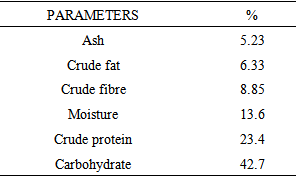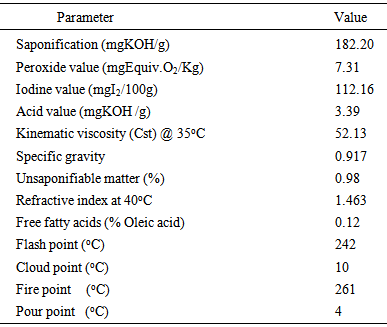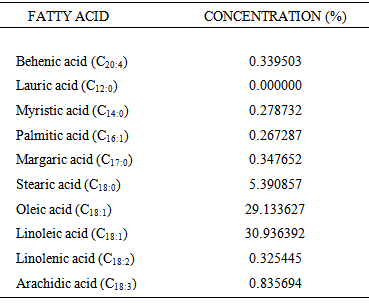| [1] | Ndunguru, J. & Rajudu, A. C. (2004). Effect of okra mosaic virus disease on the ground morphological yield component of okra in Tanzania. Sci. Horti. 99, 225-235. |
| [2] | Franklin, W.M. (1982): Okra, potential multiple purpose crop for the temperature zones and tropics. Economic Botany, 36, 340-345. |
| [3] | Pearson, D. (1979) Chemical analysis of foods,7th ed. Churchill Livingstone, London. |
| [4] | AOAC (2005). Official Methods of analysis. 15th edition. Association of Official Analytical Chemists, Washington D. C. |
| [5] | Ogungbenle, H.N. (2003). Nutritional evaluation of quinoa flour, Int. Journal Food Science and Nutrition. 54, 153-158. |
| [6] | Ogungbenle, H.N. (2014). Sugar, physico chemical properties and fatty acid composition velvet tamarind pulp and oil. Euro. J. Biotech. Bioscience, 2(3), 33-37. |
| [7] | Nzikou, J.M., Mvoula Tsieri, N.P.G. Pambou Tobi, C.B. Ndangui, A. Kimbongui, Th. Silou, M. Linder, J. Scher & S. Desobry (2010). Proximate composition and physico chemical characteristics of seed and seed oil from Terminalia catappa L. and the kinetic of degradation of the oil during heating. Austr. J.Basic Appl.Sci. 4, 2039-2047. |
| [8] | Baker, A.E. (1984). Lubricant properties and test methods: Hand book of lubrication, theory and practice of tribology, Vol. 1, Ed. E. R. Booser, CRC Press, pp. 481-515. |
| [9] | Hall, G.M. (1982).Silage from tropical fishes: Lipid behavior, J. Food Technol., 21, 45-54. |
| [10] | Oshodi, A.A., Ogungbenle, H.N. & Oladimeji, M.O. (1999). Chemical composition, functional properties and nutritionally valuable minerals of benniseed, pearl millet, quinoa seed flour. International Journal of Food Science Nutrition. 50, 325 – 331. |
| [11] | Ogungbenle, H. N. & Atere, A.A. (2014). The chemical, fatty acid and sensory evaluation of parinari curatellifolia seeds. British Biotechnology Journal, 4(4), 379-386. |
| [12] | Adeyeye, E.I, A.A. Oshodi & K.O. Ipinmoroti (1994): Functional properties some varieties of African yam bean flour II. Int. J. Fd. Sci. Nutr. 45, 115-126. |
| [13] | Olaofe, O., Yinka, O. & M.O. Aremu (2008). Chemical evaluation of the nutritive value of smooth Luffa cylindrica seed’s kernel. Electronic Journal of Food Chemistry, 7, 3444 -3452. |
| [14] | Oshodi, A. A. & Ekperigin, M. M. (1989): Functional properties of Pigeon pea (Cajanus Cajan) flour. Food Chemistry, 34, 187-191. |
| [15] | Aletor V.A and Aladetimi, O.O. (1989): Compositional evaluation of some cowpea varieties and some underutilized edible legumes in Nigeria. Die Nahrung, 33(10) 999-1007. |
| [16] | Platt, B.S. (1962): Table of representation values of foods commonly used in tropical countries. London: 10-12. |
| [17] | Ogungbenle, H.N. (2014). Chemical and amino acid composition of raw and defatted African mango kernel. British Biotechnology Journal, 4(3) 244-253. |
| [18] | Oyenuga, V.A. (1978) Nigeria`s Foods and Feeding Stuffs. Their Chemistry and Nutritive Value. Ibadan Univ. Press, Ibadan, P 89. |
| [19] | Nwokolo, E. & Sim, J.S. (1987). Nutritional assessment of defatted oil meals of melon and fluted pumpkin (Telfara occidentalis), J. Sci. Food Agric. 3, 238-246. |
| [20] | Adeyeye, E.I., Oshodi, A.A. & ipinmoroti K.O. (1999): Fatty composition of six varieties of dehulled African yam bean (Sphenostylis stenocarpa). Int J. Food. Sci. Nutr. 50, 357-365. |
| [21] | Fagbemi, T.N. & Oshodi, A.A. (1991): Chemical composition and functional properties of full fat fluted pumpkin seed flour. Nig. Food Journal, 9, 26-36. |
| [22] | Tindal, H.D. (1983). Vegetables in the tropics. Macmillan Education Ltd. Houndmills Hampshire. pp. 533. |
| [23] | Reddy, N.R., Pearson, M.D., Sathe, S. K. & Salunkhe, D.K. (1984): Chemical, nutritional and physiological aspects of dry beans carbohydrates: a review. Food Chem. 13.25-29. |
| [24] | Akbar, E., Yaakob, Z., Kamarudian, S.K., Ismail, M. & Salimon, J. (2009): Characteristics composition of Jatropha curcas oil seed from Malaysia and its potential as biodiesel feedstock .European Journal of scientific Research, vol.29, no 3,396-403. |
| [25] | Paul, A.A. & Southgate D.A.T. (1985). McCance and Widdowson’s The composition of Foods, 4th edition. The Royal Society of Chemistry, HMSO, London, UK. |
| [26] | Ezeagu, I.E, Petze K.J., Lange, E. & Metges, C.C. (1998): Fat content and fatty acid composition of oils extraction from selected wild gathered tropical plant seed from Nigerian. J. American Oil Chemists, 75(8):1031-1035. |
| [27] | Akanni M.S., Adekunle, A.S. & Oluyemi, E.A. (2005): Physiochemical properties of some non-convention oil seeds. Journal Food Technology 3(2), 177-181. |
| [28] | Eromosele, I.C., Eromosele, C.O, Akintoye, A.O. & Komolafe, T.O. (1994); Characterization of oils and chemical analysis of the seed of wild plants. Plant Food and Human Nutrition, 46,361-365. |
| [29] | Fernamado, C.E.C., & Akujobi, E.O. (1987): Chemical analysis vegetable oils and fats Sokoto State of Nigeria. J. Basic Applied Science.1:11 |
| [30] | Ogungbenle, H.N. & Memenada, O.H. (2013). Physico chemical and fatty acid composition of Nigerian periwinkle. Elixir Applied Chem. 65, 19973-19975. |
| [31] | Dosumu, M.I. & Ochu, C. (1995): Physicochemical properties and fatty acid composition of lipid extracted from some Nigerian fruits and seeds. Global Journal Pure & Appl. Science. (1), 45-50. |
| [32] | Olaofe, O, Ogungbenle, H.N., Akhadelor, B.E., Idris, A.O., Omojola, O.V., Omotehinse, O.T. & Ogunbodede, O.A. (2012). Physico chemical and fatty acids composition of oils from some legume seeds. IJBPAS, 1, 355-363. |
| [33] | Abayeh, O.J., Ama, E.A & Okoungbae, C.O. (1998): Oil content and oil quality characteristics of some Nigerian oils seeds; Science Forum: Journal of Pure and Applied science 1 (1), 17-23. |
| [34] | Oderinde, R.A., Ajayi I, A. & Adewuyi, A. (2009): Characterization of seed and seed oil of Hura crepitians of degradation of the oil during heating, Elect. J. Env. Agr. Food Chem. 8(3), 201-208. |
| [35] | Akintayo, E.T. (1997): Chemical composition and physicochemical properties of fluted pumpkin (Telfaira occidentalis) seed and seed oils, Riv. Italia Sos. Grasse. 74, 13-15. |
| [36] | Akpan, U.G. (1999): Extraction and characterization of neem seed oil. In (Ed) A.A. Eyo, P.O. Aloku, S.A. Garba, U.O. Ali, S.L. lamai, S.O. Olufigba. Biotechnology and sustainable development in Nigeria`. Proceedings of the 12th Annual Conference of the Biotechnology Society of Nigeria, 63-66. |
| [37] | Ochigbo, S.S. & Paiko, Y.B. (2011). Effects of solvent blending on the characteristics of oils extracted from the seeds of Chrysophyllum albidium. Int. J. Sci. Nature, 2 (2) 352-358. |
| [38] | Akinhanmi, T.F., Atasie, V.N. & Akintokun, P.O. (2008): Chemical composition and Physicochemical properties of cashew nut (Anacardium occidentale) oil and cashew nut shell liquid. Journal of Agricultural Food and Environmental Sciences, 2(1) 1-10. |
| [39] | Mohammed, M.I. & Hamza, Z. U. (2008). Physicochemical properties of oil extracts from sesamum indicum L. seeds grown in Jigawa state, Nigeria. J. Appl. Sci. Environ. Manag., 12 (2), 99-101. |
| [40] | Akubugwu, I.E. and Ugbowu, A.E. (2007): Physiochemical studies on oils from five selected Nigerian plant seeds. Pakistan Journal of Nutrition 6(1). 75-78. |
| [41] | Olatidoye, O.P., Sobowale, S.S, Akinlitan, J.V. & Olorode, O.O (2010); Chemical composition and physiochemical characteristics of tropical almond nut (Termmalia catappa) cultivated in South West. Nigeria. J. Med. and Appl. Biosciences, 2, 1-10. |
| [42] | Deshpande Padmarag & Kevita Kulkarni (2012): Production and evaluation of diodisesel from palmoil and ghee (clarified butter), Chemical Process Engineering Research, Vol. 2, ISSN 2224-7467. |
| [43] | Demirbas, A. (2008): New liquid biofuels from vegetable oils via catalytic pyrolysis. Energy Educ. Sci. Technol., 21, 1-29. |
| [44] | Oseni, M.I., Obetta, S.E. & Orukotan, F.V. (2012); Evaluation of fatty acids profile of ethylester of yellow Oleander and groundnut oils as biodiesel feedstock. America Journal Scientific and Industrial Research, 3(2): 62-68. |
| [45] | Hawkins, C.S. & Fuls, V. (1982). Comparative combustion studies on various plant oil esters and the long term effects of an ethyl ester on a compression –ignition engine, Proc. International Conference on plant oils as fuels. ASAE St. Joseph, USA. |
| [46] | Pantzaris, T.P. & Mohamed, J.A. (2000). Palm kernel oil article. Palm oil Reaserch Institute of Malaysia (PORIM). |
| [47] | Bala, B.K. (2005): Studies on biodiesel from transformation of vegetable oils for diesel engines. Energy Educ. Sci. Technol. 15, 1-4. |
| [48] | Kulkarni, B. M., Bujar, B.G. & Shanmukkappa, S. (2008). Investigation of acid oil as a source of biodiesel. India J. Chem. Tech., 15, 467-471 |
| [49] | Kammann, K. D. & Philips, A.I. (1985). Sulphurised vegetable oil products as lubricant additive. Am. Oil Chem. Soc., 62, 917-923. |
| [50] | Oshodi, A.A., O. Olaofe & G.M. Hall (1993). Amino acid, fatty acids and mineral composition of pigeon pea, Int. J. Food Sci. and Nutri.,43,187-191. |
| [51] | Olaleye, A.A., Ogungbenle, H.N. & Ayeni, K.E. (2014). Mineral and fatty acid compositions of three fresh water fish samples commonly found in South western states of Nigeria. Elixir Food Science, 68, 21971-21975. |
| [52] | Dennys, E.C.C., Andre, G.V.C., Mariado C. G. P., Marco, T. C. S. & Neuza, M. B. C. (2006): Liquid profile of rat fed diets based on flaxseed, peanut, trout, or chicken skin. Nutrition, 22,197-205. |
| [53] | Gillian, B., Jacob, H.N, Tina, S., Chryso, S., Mick, D.E., Roy, S. & Carlos, L. (2008): Fatty acid and fat – soluble antioxidant concentrations in milk from high and low- input conventional and organic system: Season variation. J. Sci. Food Agric., 88. 1431-1441. |
| [54] | Adeyeye, E.I. (2011): Fatty acid composition of Zonocerus variegatus, Macrotermes bellicosus and Anacardium occidentale kernel. International Journal of Pharma and Bio sciences, Vol 2, B-140-184. |
| [55] | Bender, A.(1992): Meat and products in Human Nutrition in Developing Countries. FAO Food and Nutrition paper 53.Rome, FAO. |
| [56] | Zambiazi, R.C., Przybylski, R., Zambiazi, M.W. & Mendonza, C.B. (2007). Fatty acid composition of vegetable oils and fats. B. Ceppa curitia, 25, 111-120. |
| [57] | Osagie, A.U., Okoye, N.I., Oluwayose. B.O. & Dawodu, O.A. (1986); Chemical quality parameters and fatty acid composition of oils of some underexploited seeds, Nig. J. Appl. Sci.,4;151-162. |
| [58] | Bello, E.I. & Anjorin, S.A. (2012): Fatty acid composition of six Nigerian`s vegetable oils and their methyesters. Research Journal Engineering& Applied Science 1(3), 166-170. |
| [59] | Keys, A., Anderson, J.T. & Grange, F. (1957). Prediction of serum cholesterol response of man to changes in the diet. Lancet, 2, 959-966 |
| [60] | Hegsted, D.M, (1993): Calcium and Phosphorus. In Modern Nutrition in Health and Disease, ch. 6, sect. A. Lea and Febiger. Philadelphia, PA. |
| [61] | Salunkhe, D.K., Kadam, S.S. & Chavan, J.K. (1985). CRC postharvest biotechnology of food legumes. Boca Raton, FL: CRC Press. |
| [62] | Sale, R.L., Costa, N.M.B., Monteiro, J.B.R., Peluzio, M.G, Coelho, S.B, Oliveira, C.G. & Mattes, R. (1985): Efeitos dos oleos de amendom, acafrao e olive na composicao carporal, metablismo energetic, perfillipidicoe ingestao alimentarde individuos eutroficos normoli pidemicos. Revista da nutricao campinas, 18 (4) 499-511. |






 Abstract
Abstract Reference
Reference Full-Text PDF
Full-Text PDF Full-text HTML
Full-text HTML

